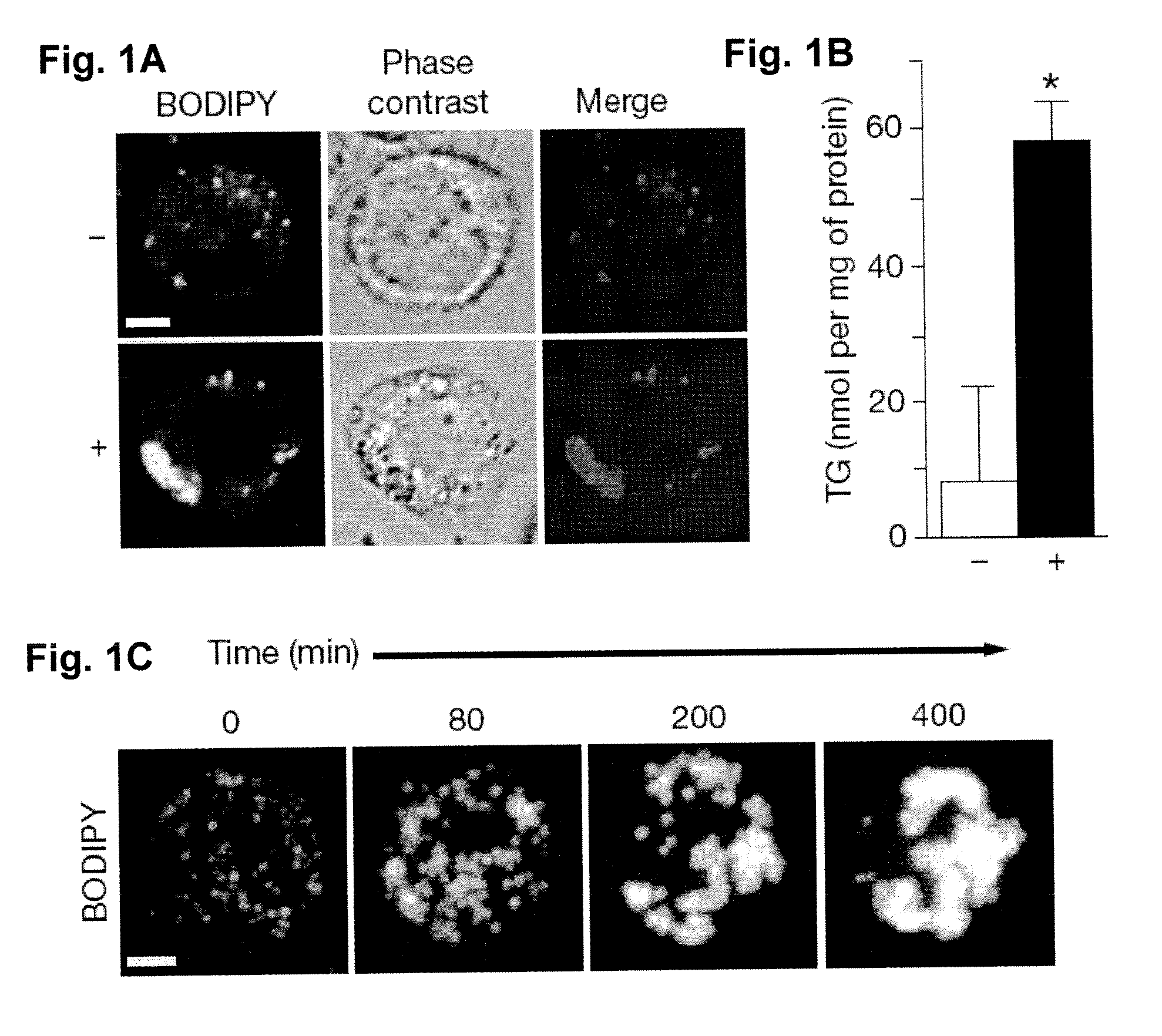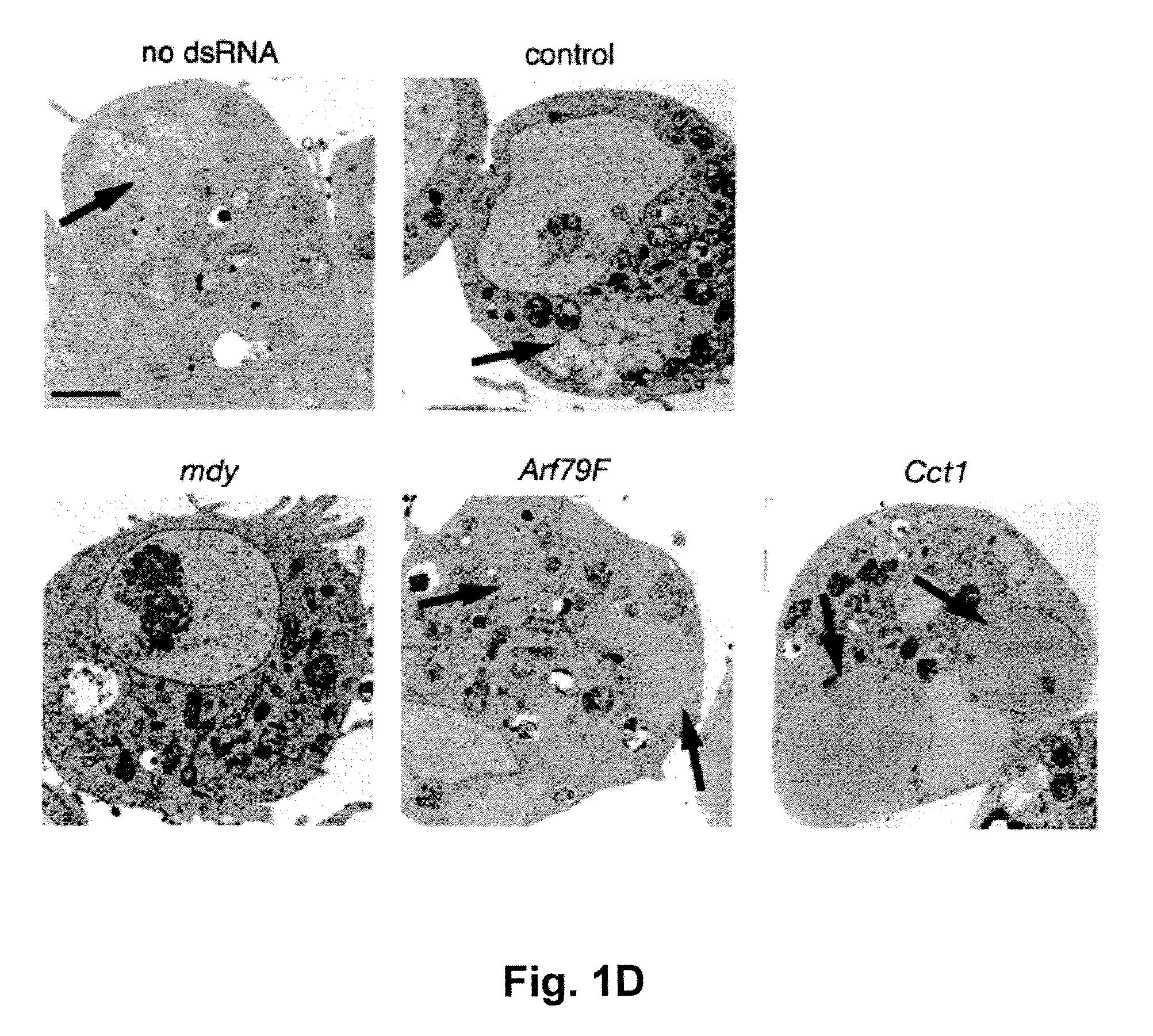Methods of Modulating Lipid Concentrations in Eukaryotic Cells
a technology of eukaryotic cells and lipid concentrations, applied in the field of lipiddroplet cell biology, can solve the problems of difficult to find biomass sources that naturally contain a high concentration of oils, and achieve the effects of increasing or decreasing expression of genes, decreasing lipid concentrations, and increasing expression
- Summary
- Abstract
- Description
- Claims
- Application Information
AI Technical Summary
Benefits of technology
Problems solved by technology
Method used
Image
Examples
example 1
Methods Summary
[0060]Chemicals and materials. Oleic acid (Sigma-Aldrich) and 10% BSA (essentially fatty acid free, Sigma-Aldrich) were used to make a 7.5 mM stock solution (5: I oleic acid:BSA molar ratio)31. BODIPY 493 / 503 was from Invitrogen.
[0061]Cell culture. Drosophila S2 cells were cultured in Schneider's Drosophila medium (Invitrogen) supplemented with 10% fetal bovine serum and antibiotics (100 unit / ml penicillin and 100 μg / ml streptomycin) at 25° C. as described32. RNAi treatment of S2 cells were performed as previously described10. A segment of pBluescript backbone was used as the template for control RNAi (referred as control RNAi thereafter). Transfection of S2 cells was performed using Cellfectin reagent (Invitrogen). Images of live cells were taken using LSM 510 confocal microscope (Carl Zeiss MicroImaging) with a 63× oil immersion lens.
[0062]RNAi-mediated genomic screen. RNAi screening with UCSF DmRNAi libraries versions 1 and 2 (15,683 genes) was as described10. The ...
example 2
Methods of Modulating Lipid Concentration in a Eukaryotic Cell-pls Review This Example 2 Quickly If You Haven't Before—It Is From the Provisional
[0076]The present invention provides methods of modulating lipid concentration in a eukaryotic cell by increasing or decreasing expression of a gene, or an ortholog of a gene, selected from the genes listed above in Table 1, Table 2 or Table 3. In one embodiment, lipid concentration is increased, either by decreasing the expression of a gene found in phenotypic classes III, IV, or V, or by increasing expression of a gene found in phenotypic classes I or II. In another embodiment, lipid concentration is decreased, either by increasing expression of a gene found in phenotypic classes III, IV, or V, or by decreasing expression of a gene found in phenotypic classes I or II.
Finding Orthologs of Genes Listed in Tables 1, 2, or 3
[0077]Orthologs of the genes listed in Tables 1, 2, and 3 may be found using any method known in the art. In one example...
example 3
Method of Identifying Disease Markers
[0081]The present invention also provides a method of identifying a diagnostic marker of a disease characterized by an excess of lipids, comprising comparing the level of expression of a gene selected from the genes listed in Table 1, 2, or 3, or an ortholog thereof, in organisms with and without said disease; determining if there is a difference in the level of expression of said gene in organisms with and without said disease; and identifying said gene as a diagnostic marker based on said determining. Gene expression may be compared using any method known in the art. In a preferred embodiment, a microarray is used to simultaneously compare expression of a large number of genes. Differences may be confirmed, for example using Northern blots, Western blots, immunocytochemistry, quantitative PCR, etc.
[0082]For example, the Drosophila gene cct1, shown here to modulate lipid drop formation, has a human ortholog, as identified in Flybase.net. This is...
PUM
| Property | Measurement | Unit |
|---|---|---|
| Concentration | aaaaa | aaaaa |
| Size | aaaaa | aaaaa |
| Morphology | aaaaa | aaaaa |
Abstract
Description
Claims
Application Information
 Login to View More
Login to View More - R&D
- Intellectual Property
- Life Sciences
- Materials
- Tech Scout
- Unparalleled Data Quality
- Higher Quality Content
- 60% Fewer Hallucinations
Browse by: Latest US Patents, China's latest patents, Technical Efficacy Thesaurus, Application Domain, Technology Topic, Popular Technical Reports.
© 2025 PatSnap. All rights reserved.Legal|Privacy policy|Modern Slavery Act Transparency Statement|Sitemap|About US| Contact US: help@patsnap.com



